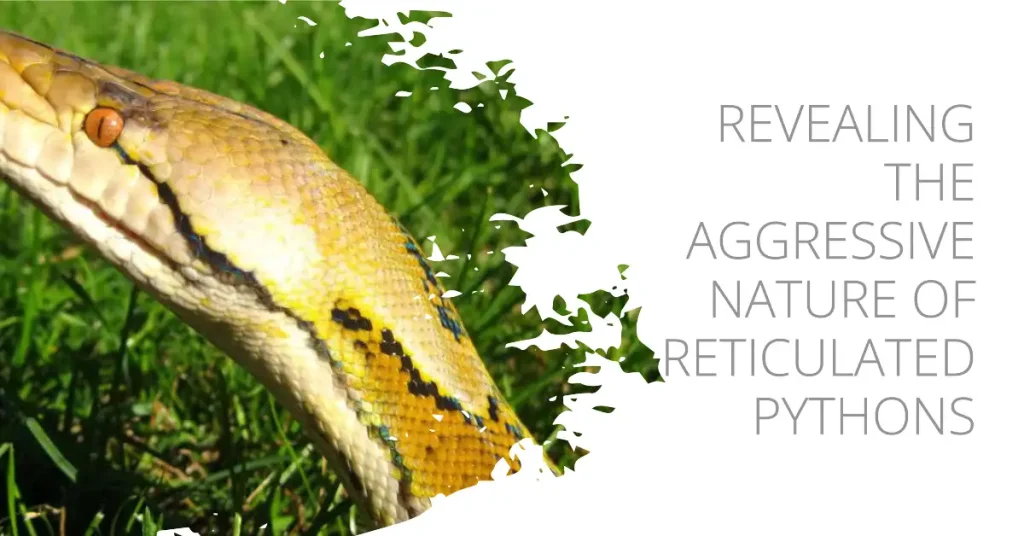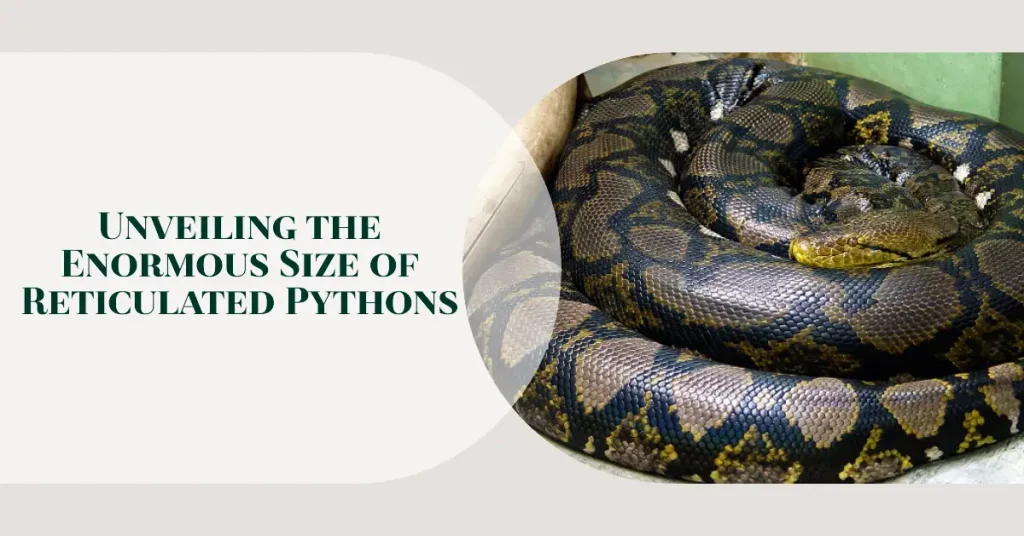In this article, I will explore the question of whether reticulated pythons are aggressive or not. I have conducted research on this topic to provide you with accurate information and a comprehensive understanding of this subject.
Many people have heard stories about the aggression of reticulated pythons and a fear of these animals is not uncommon. In this article, we’ll delve into their behavior, temperament, and the factors that may trigger their aggression. We’ll also provide practical advice on how to handle these reptiles safely and responsibly.
Key Takeaways:
- The question of whether reticulated pythons are aggressive is complex and requires a comprehensive understanding of their behavior.
- Factors that may contribute to reticulated python aggression include habitat, captivity, size, and age.
- Responsible ownership and proper care are crucial for maintaining a calm and non-aggressive temperament in reticulated pythons.
Understanding Reticulated Python Behavior
Before we explore the topic of reticulated python aggression, it’s crucial to understand their behavior. These snakes are native to Southeast Asia, and they are among the largest species of snakes in the world. A fully grown reticulated python can reach lengths of over 20 feet.
These pythons are solitary creatures, and they prefer to avoid human contact. They are primarily active at night and spend most of their days hiding in the vegetation. They are excellent swimmers and can move both on land and water with ease.
Reticulated pythons are ambush predators, and they hunt by waiting for their prey to come within range. They have keen senses of smell and can track their prey from several feet away. Once they capture their prey, they wrap their powerful bodies around it to squeeze it to death before swallowing it whole.
Interacting with Their Environment
Reticulated pythons are well adapted to their environment, and they can live in a variety of habitats, including forests, grasslands, and even near human settlements. They are excellent climbers and can scale trees with ease to hunt prey or escape predators.
These snakes are also known for their incredible strength. They can break bones and even move heavy objects with their bodies. When they are threatened, they can use their strength to defend themselves and intimidate their attackers.
Natural Instincts and Hunting Techniques
Reticulated pythons have a natural instinct to hunt, and they use a variety of techniques to catch their prey. One of their most common hunting techniques is to lie in wait for their prey to come near and then ambush it.
They also use their keen senses to locate their prey, which can include anything from small mammals to birds and reptiles. Once they have located their prey, they will stalk it until they are close enough to strike.
Their powerful bodies allow them to constrict their prey and suffocate it. They then swallow their prey whole, sometimes taking several hours to do so.
Exploring Reticulated Python Aggression
While reticulated pythons generally have a docile nature, they can become aggressive under certain circumstances.
One common trigger for aggression is when these pythons feel threatened. For instance, if they perceive a human or another animal as a potential threat, they may lash out. Other factors that may contribute to aggression include hunger, stress, and inadequate environmental conditions.
In terms of defensive mechanisms, reticulated pythons have several strategies for protecting themselves. When threatened, they may hiss, strike, or constrict their enemy. The latter is a particularly effective method since it can crush the bones of the prey and cause suffocation.
However, it’s worth noting that most cases of aggression towards humans are caused by improper handling or lack of supervision. Reticulated pythons can become stressed and aggressive if they feel insecure or frightened. Therefore, it’s critical to handle these reptiles with care and respect their boundaries.
In the next section, we will discuss how to deal with aggressive reticulated pythons and provide practical advice on how to ensure both their safety and ours.
Are Reticulated Pythons a Threat to Humans?
As with any large predator, there is always some risk when encountering a reticulated python in the wild. However, despite their reputation, reticulated pythons are generally not a threat to humans.
According to documented cases, most encounters with reticulated pythons end peacefully, with both the python and human going their separate ways. In fact, most cases of aggression towards humans occur when the python feels threatened or intimidated.
It is important to remember that these pythons are not natural predators of humans and are not seeking us out as prey. Instead, they are simply going about their lives in their natural habitat, and we are merely passing through.
However, it is still essential to take safety precautions when encountering a reticulated python. This includes keeping a safe distance, avoiding sudden movements that may startle the python, and never attempting to handle or provoke the animal.
If you do encounter a reticulated python in the wild, it is always best to give the animal a wide berth and let it go about its business. If you are concerned about the python’s presence, contact local authorities and let them handle the situation.
Dealing with Aggressive Reticulated Pythons
If you own a reticulated python, it’s important to understand how to handle aggressive behavior to ensure your safety and the well-being of your pet. Here are some tips on how to deal with aggressive reticulated pythons:
- Stay calm: If your reticulated python is showing signs of aggression, it’s essential to remain calm. Do not make any sudden movements or loud noises, as this may exacerbate the situation.
- Use a hook: If your reticulated python is aggressive, a hook can be a useful tool for handling. Use the hook to gently guide your python into a safe space, such as a separate enclosure or a holding box.
- Wear appropriate gear: When handling an aggressive reticulated python, it’s essential to wear protective gear such as gloves and long sleeves to reduce the risk of bites or scratches.
- Get help: If you are not comfortable handling an aggressive reticulated python, it’s best to seek assistance from a professional snake handler or veterinarian.
- Minimize stress: Reticulated pythons can become aggressive when they are stressed. Ensure that your python’s enclosure is spacious and provides adequate hiding spots and environmental enrichment.
- Evaluate the root cause: Understanding the underlying cause of your python’s aggression can help you take appropriate steps to address the issue. Is your python feeling threatened or scared? Is it hungry or in pain?
- Train your python: Through consistent handling and positive reinforcement, you can encourage your reticulated python to develop a calm temperament. However, aggressive pythons should not be handled by inexperienced owners.
Remember, handling an aggressive reticulated python can be dangerous. Always prioritize your safety and seek help if necessary. By understanding your python’s behavior and taking appropriate precautions, you can minimize the risk of aggression and ensure a happy and healthy life for your pet.
Factors Influencing Reticulated Python Aggression
Understanding the temperament of reticulated pythons can be complex, as it can be influenced by various factors. These factors can play a significant role in determining the level of aggression displayed by these reptiles.
Habitat
The natural habitat of reticulated pythons includes rainforests, swamps, and grasslands. Their environment has a significant impact on their behavior, as they are accustomed to living in confined spaces with low light levels. Captive-bred reticulated pythons tend to be less aggressive, as they are raised in an environment with more space and light. However, wild-caught pythons may be more prone to aggressive behavior due to their natural habitat.
Captivity
Captive reticulated pythons can display various emotions, depending on how they are raised. Pythons that are socialized from an early age and are accustomed to human interaction tend to be less aggressive. However, those that are not socialized or are mistreated may become more aggressive.
Size
The size of a reticulated python can influence its behavior. Younger pythons tend to be more active and curious, while larger pythons may be more docile. However, larger pythons may also be more aggressive, as they require more space and food.
Age
The age of a reticulated python can also impact its behavior. Younger pythons tend to be more aggressive and defensive, as they are still developing their hunting and defensive skills. Older pythons may be more docile and less prone to aggression.
By understanding these factors, owners can better understand and manage their reticulated pythons’ behavior to ensure they remain safe and healthy.
Myths and Misconceptions about Reticulated Python Aggression
There are many myths and misunderstandings surrounding the aggression of reticulated pythons. As a professional journalist, it is my duty to provide accurate information and debunk any false claims. Below are some common myths about reticulated python aggression.
-
- Reticulated pythons are always aggressive.
This is simply not true. Like most animals, reticulated pythons do not always exhibit aggressive behavior. Their temperament is influenced by various factors such as their environment, age, and level of stress.
-
- Reticulated pythons attack humans without provocation.
While there have been reported cases of reticulated pythons attacking humans, it is important to note that the circumstances leading to such encounters are often complex. Most attacks occur when the python feels threatened or provoked.
-
- Reticulated pythons are more aggressive than other python species.
There is no evidence to support this claim. It is important to remember that each individual python has its own unique temperament that is influenced by a variety of factors.
-
- Captive-bred reticulated pythons are less aggressive than wild-caught ones.
While captive-bred reticulated pythons may be more accustomed to human interaction, they can still exhibit aggressive behavior if they feel threatened or stressed.
It is important to approach reticulated pythons with caution and respect. By understanding their behavior and needs, we can reduce the risk of aggression and promote a safe and healthy environment for all.
The Importance of Responsible Ownership
It is important for me to emphasize the significance of responsible ownership when it comes to reticulated pythons. These are complex reptiles that require specific care and attention. Therefore, it is crucial to understand their behavioral patterns in order to provide an environment that promotes their well-being.
Owners of reticulated pythons must provide a spacious and suitable enclosure that mimics their natural habitat. It should have proper lighting, heating, and humidity levels. This ensures that they can move freely, regulate their temperature, and molt properly. Neglecting these aspects can lead to health issues and stress, which can cause aggression.
Proper handling techniques are also essential for minimizing the risk of aggression. Owners should handle their reticulated pythons with respect and care. They should avoid sudden movements, loud noises, and rough handling. These reptiles have a flight or fight instinct, and any perceived threat can trigger defensive behavior.
Lastly, reticulated pythons are not meant for everyone. They require a significant commitment of time, resources, and expertise. Therefore, it is important to ensure that you are prepared for the responsibilities that come with owning one. If you are unsure, consider consulting with a professional before making any decisions.
To summarize, responsible ownership of reticulated pythons is crucial for their well-being and for minimizing the risk of aggression. By providing a suitable environment, proper handling techniques, and taking responsibility for their care, owners can ensure a safe and healthy life for these complex reptiles.
Tips for Encouraging a Calm Temperament in Reticulated Pythons
While reticulated pythons can display aggressive behavior, there are several strategies that can be employed to promote a calm temperament. As a responsible owner, it is essential to ensure your python is comfortable and secure in its environment, reducing the likelihood of stress and anxiety.
Here are some tips for encouraging a calm temperament in your reticulated python:
- Provide adequate space: Ensure your python has enough room to move around comfortably. A cramped enclosure can cause stress and lead to aggressive behavior.
- Offer a comfortable substrate: Choose a substrate that is easy to clean and provides your python with a comfortable surface to rest on. Avoid sharp or rough materials that may cause injury.
- Add environmental enrichment: Provide branches, hides, and other items that mimic your python’s natural habitat. This allows them to explore and engage in natural behaviors, reducing boredom and potential aggression.
- Handle your python appropriately: Avoid handling your python too frequently or roughly, as this can cause stress and anxiety. Always support their weight and move slowly and gently.
- Feed your python correctly: Ensure your python is fed an appropriate diet and on a regular schedule. Overfeeding or underfeeding can cause stress and lead to aggressive behavior.
- Keep the enclosure clean: Regularly clean and maintain your python’s enclosure to minimize stress and prevent the spread of illness or disease.
By following these tips and providing a comfortable and secure environment, you can encourage a calm temperament in your reticulated python. Remember, always approach your python with caution and respect, as they are still wild animals with natural instincts.
Conclusion
In conclusion, reticulated pythons are not inherently aggressive, but certain factors may trigger their defensive mechanisms. Understanding their natural behavior, habitat, and size is crucial in preventing aggression. It is essential to provide a stress-free environment that promotes their well-being and comfort.
Misunderstandings and myths surrounding reticulated python aggression should be debunked, and accurate information should be disseminated. Responsible ownership plays a significant role in ensuring the safety of both the owner and the python.
In promoting a calm temperament in reticulated pythons, environmental enrichment, proper handling techniques, and stress reduction are pivotal.
Overall, reticulated pythons are fascinating creatures that require proper care and attention. With responsible ownership and a comprehensive understanding of their behavior, they can make excellent pets.
FAQ
Q: Are reticulated pythons aggressive?
A: Reticulated pythons can exhibit aggressive behavior, especially when they feel threatened or cornered. However, it is important to note that not all reticulated pythons are aggressive, and their temperament can vary based on various factors.
Q: What factors influence reticulated python aggression?
A: The aggression of reticulated pythons can be influenced by factors such as their habitat, captivity conditions, size, and age. These factors play a role in shaping their behavior and level of aggression.
Q: Do reticulated pythons pose a threat to humans?
A: While reticulated pythons are large and powerful snakes, they generally do not pose a threat to humans unless provoked or handled improperly. It is important to exercise caution and follow proper safety precautions when encountering these snakes.
Q: How can I deal with aggressive reticulated pythons?
A: Dealing with aggressive reticulated pythons requires knowledge and caution. It is recommended to seek professional assistance when handling aggressive pythons. Implementing safety measures, effective handling techniques, and minimizing stress can help in managing their aggression.
Q: What are some myths and misconceptions about reticulated python aggression?
A: There are several myths and misconceptions surrounding reticulated python aggression. It is important to debunk these misconceptions and rely on accurate information backed by scientific research to understand their behavior.
Q: How can I encourage a calm temperament in reticulated pythons?
A: Promoting a calm temperament in reticulated pythons involves providing a suitable environment with proper enrichment, handling them with care and respect, and ensuring a stress-free living condition. These factors can contribute to a calmer behavior in these snakes.
Q: What is the importance of responsible ownership of reticulated pythons?
A: Responsible ownership is crucial when it comes to reticulated pythons. It entails providing proper care, handling, and creating an appropriate living environment for these reptiles. Responsible ownership ensures the well-being of the python and reduces the risk of aggression.
Featured image: Kyle Zimmerman, CC BY-SA 4.0, via Wikimedia Commons


